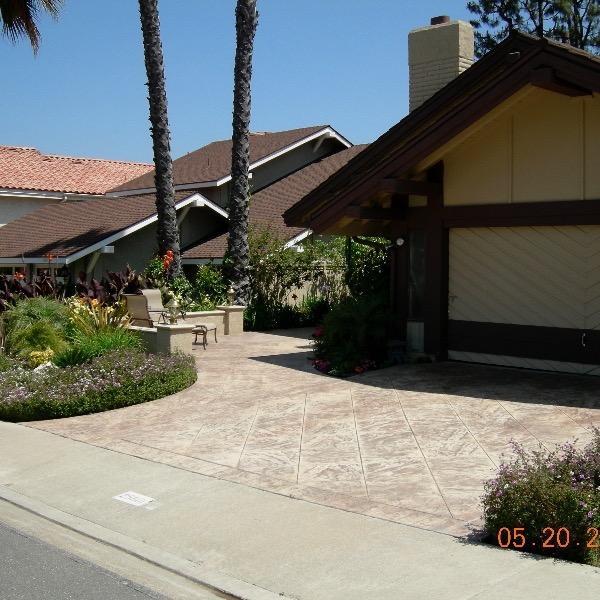
The word groundcover is exactly what it sounds like. Anything that covers or touches the ground that enables plants or soil to be covered. Mulch and rock groundcovers serve to keep soil from eroding and moving to other areas of your landscape , allowing the moisture to be kept within the plant beds.
Frequently, ground cover plants are selected for aesthetic reasons, such as to add fresh colors or textures to a landscape. Alternatively, they may be chosen for practical reasons to cover areas where turf grass does not thrive or is impractical. For instance, heavily shaded sections of a yard may be an ideal location for an alternative shade-tolerant ground cover plant, such as ajuga or pachysandra. Planting ground cover on steep slopes that are difficult to mow might also be advantageous. In arid climates where grass’s high water requirements are troublesome, an alternate ground cover can completely replace grass.
When covering huge areas of landscape, the initial cost will be significantly more than when sowing grass seed. On the other hand, ground covers may save you money in the long term by eliminating expenses such as excessive feeding, watering, and lawnmower fuel and upkeep.
The cover crop should not be confused with ground cover. These are distinct plant groups, despite some overlap. A cover crop is a plant used as a form of live mulch, typically in vegetable gardening or industrial food production. Typically, a cover crop is an annual plant that is planted in a garden or field to grow for a season and then be tilled into the soil to supply nutrients. In contrast, ground coverings are beautiful perennial plants intended to cover a large area of land for many years.
Once the plants are established, there is no mowing, little weeding, edging, and minimal, if any, watering or fertilizing. And unlike many fussier plants, deadheading, pruning spent growth, dividing, and replanting are not necessary.
Groundcovers, when planted in large swaths, can provide the openness of a grassy lawn, but with more texture. Small drifts of three or more plant types can create the layered appearance of flower beds without the annuals’ boom-and-bust cycles.
Between lawns and natural woodland areas, groundcovers create attractive buffer zones. Along pathways, patios, driveways, and retaining walls, they also soften the appearance of paved surfaces.
Mass plantings tend to slow the movement of precipitation down a slope, while the foliage cushions the impact and the roots bind the soil and absorb moisture. In addition, you need not worry about slipping as you tend to the plants, as there is minimal actual labor involved.
Various functions can be served by ground cover plants in the landscape:
Before planting, we pay special attention to trimming or removing weeds, especially perennial weeds, from the bed.
As with any permanent landscape planting, preparation time pays off. Before planting, pay special attention to removing weeds, especially perennial weeds, from the bed. Grass and weeds can be eliminated by applying a nonselective systemic herbicide or by covering the area with a sheet of black plastic for 1-3 months.
If using a herbicide, adhere to all label instructions regarding application timing, mixing, and application. If this is not done, the weeds will re-grow, compete with the new plantings, and hinder the groundcover’s establishment. Once the weeds have been eliminated, they can be incorporated into the soil. (Remove any seed heads prior to cultivation.) Add organic matter to the area and till it to a depth of 6 to 8 inches in order to improve the soil’s tilth.
Per 100 square feet, apply one to two pounds of 5-10-5 or a similar fertilizer. After the site has been prepared, if possible, leave it unplanted for two to three weeks. During this period, any perennial weeds that have not been eradicated will regrow and can be easily eliminated. This reduces the likelihood of a significant weed invasion after the area has been planted.
Most groundcovers are planted in the spring or fall. Summer planting requires increased watering care. It may be necessary to mulch fall-planted groundcovers to prevent frost heaving of the plants. The distance between plants depends on the plant’s growth pattern, cost, and how quickly the area must be covered. In general, faster-growing groundcovers should be spaced further apart than slower-growing varieties. (See spacing chart for guidelines on number of plants required for certain square footage and spacing suggestions.) For optimal results, plant groundcovers in a staggered or diamond pattern. When planting on slopes, mulch the area after planting or plant through fiber netting to help hold the soil in place. Allow at least one to two growing seasons for the area to become completely established. Groundcovers require a minimum amount of maintenance once established.
Once established, groundcovers require a minimal amount of maintenance. Irrigate newly planted groundcovers so their roots can establish themselves. Maintain a weed-free environment through shallow cultivation. After the first season, water only during dry summer and fall periods.
The most important step in weed control occurs prior to planting, during bed preparation. Eliminate all perennial weeds from the bed when preparing the soil. During establishment, weed control should be accomplished through frequent shallow cultivation and manual pulling. One to two inches of mulch suppresses weed growth and maintains soil moisture. Some ground cover may require occasional pruning to remain within the allotted space. Pruning older stems will allow for the regrowth of younger, more robust, and aesthetically pleasing foliage.
To request a quote, contact us at Signature Landscape today!
Schedule A Consultation